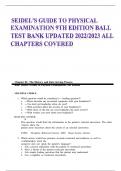Exam (elaborations)
SEIDEL'S GUIDE TO PHYSICAL EXAMINATION 9TH EDITION BALL TEST BANK UPDATED :COMPLETE SOLUTION
SEIDEL'S GUIDE TO PHYSICAL EXAMINATION 9TH EDITION BALL TEST BANK UPDATED :COMPLETE SOLUTIONSEIDEL'S GUIDE TO PHYSICAL EXAMINATION 9TH EDITION BALL TEST BANK UPDATED :COMPLETE SOLUTIONSEIDEL'S GUIDE TO PHYSICAL EXAMINATION 9TH EDITION BALL TEST BANK UPDATED :COMPLETE SOLUTIONSEIDEL'S GUIDE TO PHYSI...
[Show more]
Preview 4 out of 434 pages
Uploaded on
August 25, 2024
Number of pages
434
Written in
2024/2025
Type
Exam (elaborations)
Contains
Questions & answers
$15.99
100% satisfaction guarantee
Immediately available after payment
Both online and in PDF
No strings attached
Chapter \01: \The \History \and \Interviewing \Process




